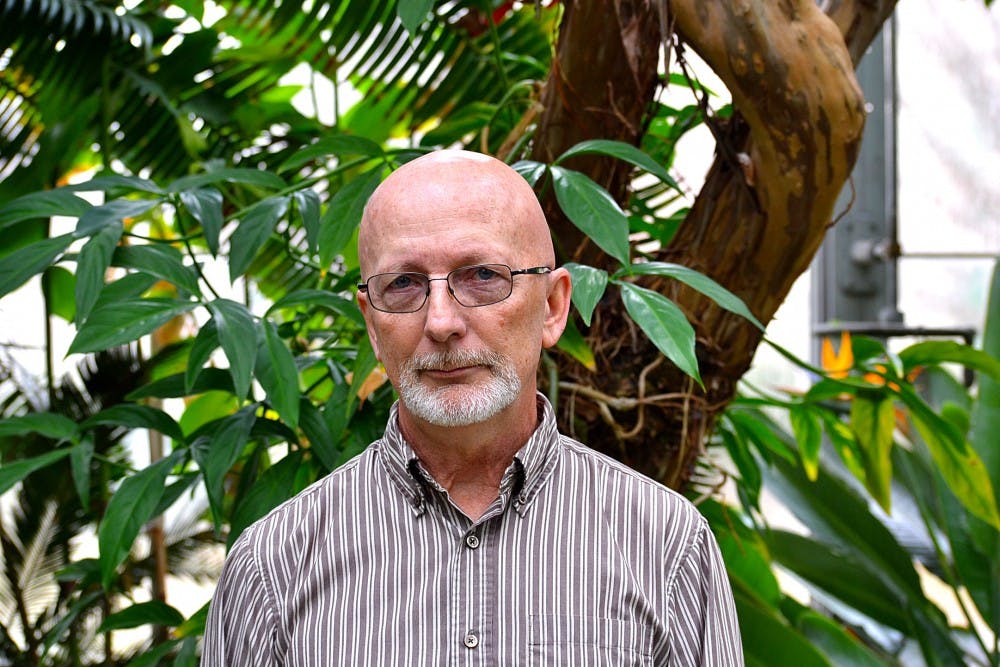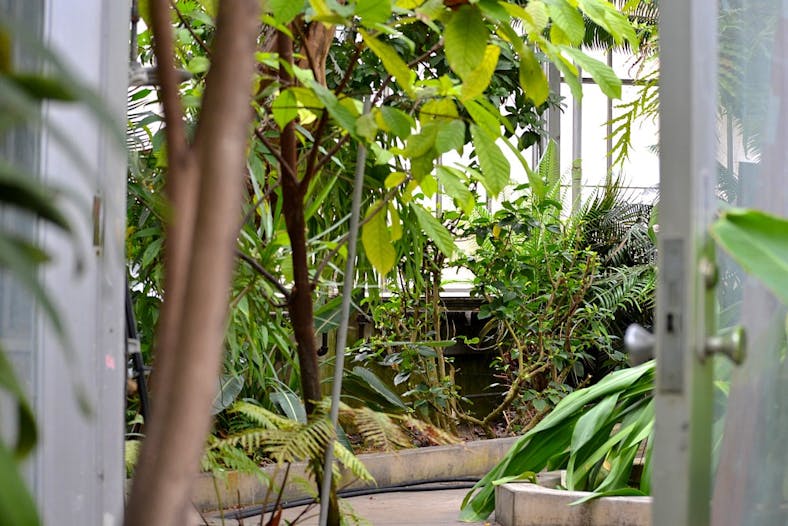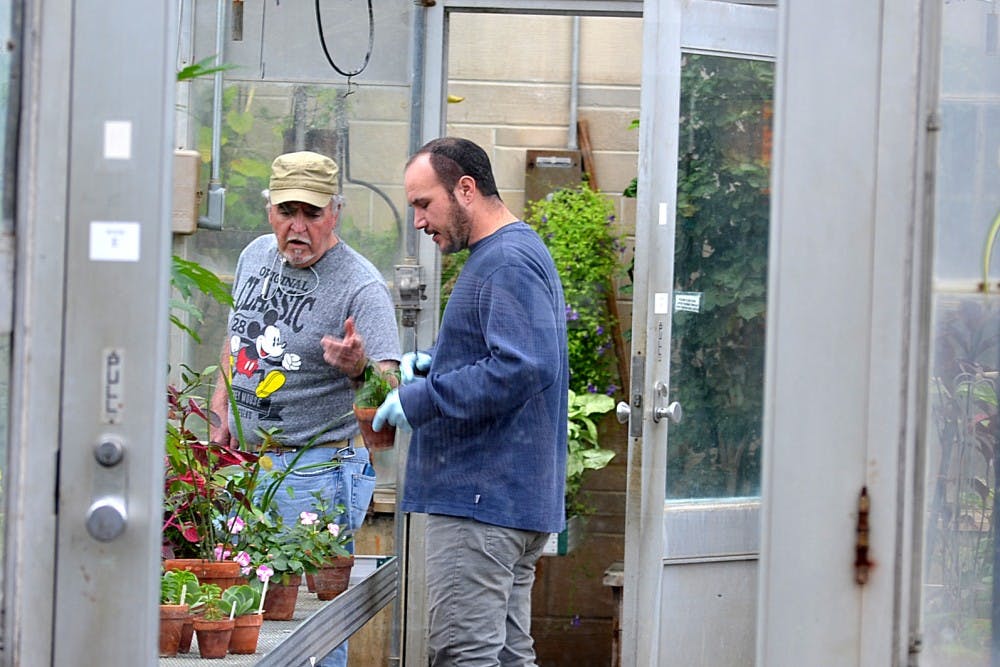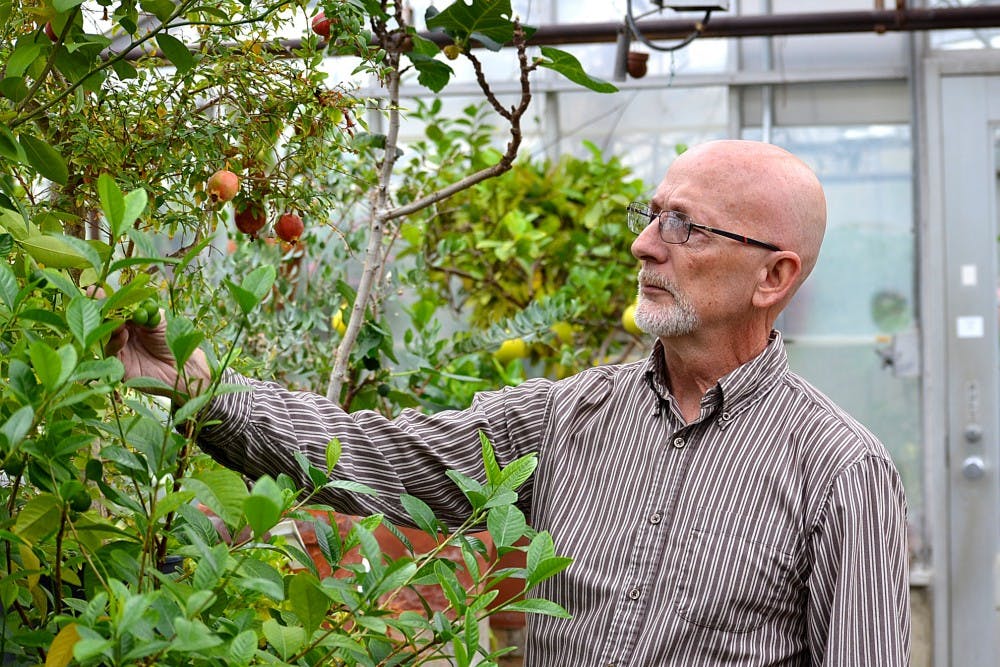Sometimes he dreams about the greenhouse.
John Lemon sees his 20-year-old self in the misty rooms among countless plants he’s cared for for almost half a century, poking his hands in the dirt, checking if the coleus plants need to be watered or re-potted. He recognizes gardeners from years ago, those he apprenticed with, those who are not even alive. They drive to the cornfield in the fall like they used to. It is the harvest season, and everything is golden.
Then the 66-year-old wakes up. His dreams have blurred away, along with his carefree days. And the people have been long gone. Then he sets off to the Jordan Hall Greenhouse in front of the IU biology building, to see those plants in his dreams.
It’s Lemon’s 46th year serving the greenhouse. No time for nostalgia. Fretting plants await.
* * *
At 7 a.m., after a long night, thousands of plants quiver spiritedly as streams of water run through their body and seep into the soil. Lemon looks down attentively, administering to the needy.
He drags the water hose along the aisles and careful scratches on the soil in the pots, checking which ones need water and which ones don’t.
The majority of the plants require daily watering, while some desert plants such as cacti need to stay dry. Flytrap, pitcher plants and other insect-catching plants are too delicate for tap water, needing deionized water from a different hose.
After dedicating 46 years to the Jordan Hall Greenhouse, Lemon knows the plants’ different quirks by heart.

His day at the greenhouse starts around 7 a.m., whether winter or summer, rain or shine. He goes around all 11 rooms twice a day to water and check plants for bugs, diseases and if they need to be pruned or re-potted.
Things are more active here as the greenhouse retains more light and higher temperature.
“They’re all just one day away from dying if somebody doesn’t take care of them,” Lemon says.
The plants depend on the gardeners for their survival. This responsibility is life-or-death.
“Our days are always different around here,” Lemon says.
A well-honed gardener is always on the lookout and prepared for all the mishaps.
Incidents arise unexpectedly, and crisis can escalate fast. Despite the temperature control system, the glass rooms still get heated and frozen easily. The thin piece of glass wrapped around the greenhouse has no insulation, making it difficult to preserve heat when outside is below zero.
More than once Lemon had to drive here in the middle of the freezing night, when low temperature alarms woke him up. He could have just checked the temperature control on his computer, but the system couldn’t tell him if the vent stayed ajar or the heaters went out. He had to know exactly what happened.
Most of the time, however, there was not much he could do in the face of winter’s cruelty. He just turned on all the lights and hoped they could pull through the night.
Lemon is also in charge of others’ research projects. To ensure an unaffected outcome, the gardeners have to ensure plants receive the right soil and fertilizer and the right amount of water during their months or even years of stay in the greenhouse.
But the old gardener doesn’t take much credit for the glory of the scholarly progress.
“As long as everything is run smoothly, it’s a success,” he says. “One day at a time.”
* * *
The wildly growing spiny tree catches Lemon’s eye. He decides to move it to the tropical room with a higher ceiling before it soon outgrows its current residence.
Ceiba speciose, or the silk floss tree, is native to Uruguay. It is one of many exotic plants in the greenhouse. The most glamorous story in the greenhouse belongs to the Amorphophallus Titanum “Wally,” the famous corpse flower.
In July 2016, the 8-year-old odorous flower attracted 5,000 people with its first rare bloom. Curious crowds flocked to the greenhouse and formed winding long lines. People craned their necks to see the fleeting bloom of the flower that smells like death.
Wally’s kind originates from the rain forest in Sumatra, Indonesia. The jungle room is able to mimic the high humidity and warmth of its native habitat, allowing Hoosiers in the middle of North America to witness a wonder their ancestors wouldn't have been able to conceive.
Humans' obsession for exotic plants can be traced back thousands of years. Travelers collected plants from exotic lands and tried to bring them back to Europe and North America. But it was hard for plants to thrive even if they survived the journey due to a lack of knowledge on how to preserve them.
Now with sophisticated designs and modern greenhouse technology, the world landscape and even evolutionary history can be condensed into the secret oasis on Third Street.
In the greenhouse, students can discover many kinds of orchids extinct in their native environment, and coffee trees, vanilla beans and cocoa that produces their Starbucks drink.
IU geology class E114: Dinosaurs and Their Relatives tour the greenhouse every fall to explore the earliest evolution of plants.
Giant Dioon, a palmy plant, is one of the most primitive plants not only in the greenhouse, but in the world: its existence predates modern history. It survived herbivore dinosaurs and worldwide catastrophes. Though many species from the same era no longer exist, the Giant Dioon still tells the secrets of millions of years of history.

* * *
Lemon was a janitor at IU in 1972 when he was 20. He had been cleaning classrooms and offices since summer breaks in high school. His life took a turn one day when he filed an application for a job he knew about through an acquaintance.
He then became an apprentice at the greenhouse. He had no formal training and zero greenhouse experience. When he first started it, he had no idea it would be his job for a lifetime.
“I thought working at a greenhouse would be a fun place to work,” he says. “I like plants and I like to garden. I thought it would be an interesting job to try.”
He thought about going to college and began taking history and English composition. But he decided he was satisfied with what he did at the greenhouse.
“It’s just one of those things that when you are young, you make these decisions, whether they’re right or wrong,” he says. “You can always look back and say, well I should’ve done this, or I should’ve done that. But who knows how my life would be different if I had done something else. Maybe I’d be happier maybe I’d not. I don’t think about it. It doesn’t bother me.”
There was no internet back then, so he had to thumb through stacks of books about botany and horticulture to find names of different species. He learned invaluable lessons from watching people work in the greenhouse.
“If someone takes a plant and repots it and prunes it right in front of you, you learn more by watching that than you do by reading how to it in a book,” Lemon says.
There were three Johns in the greenhouse after he joined: himself, John Reedy, the supervisor at the time, and gardener John Lucas. The two other men were both in their 50s and had worked in the greenhouse for a long time. Lemon was able to learn a lot from them, and despite the age difference, Lemon got along with them well.
“I just felt at home right away,” he says.
In the fall, they used to go out to the research cornfields and pull the single-row corn binder behind the tractor. The binder cut the corn off, and they bundled it up, kicked it out to the side and went out to gather up the corn. Researchers didn’t need all corn and seeds, so they hauled the rest on a wagon for a nearby farmer’s cattle to eat.
It was part of his job, but Lemon enjoyed getting outside and escaping his usual workplace. He was young and carefree.
But pretty soon he became the only person left. Reedy retired in 1977. Then Lucas retired in 1984. He was sad to see them go.
They still met at least once a month after the retirement for lunch and catching up. They stayed friends and kept track of one another for many years, until the other two passed away.
Lemon still thinks about them. He thinks about working together with them, about growing poinsettia together around Christmas time every year. Reedy taught Lemon how to take care of them.
After the other two Johns left, he kept the tradition of growing the Christmas flower for many years. He watered them, checked their leaves for vermin and watched the beautiful red and white flowers in full bloom.
He doesn’t grow as many as he used to anymore. Other plants have taken the space.
Sometimes Lemon wishes they were still around, then he’ll chuckle. They would be more than 100 years old if they were still alive.
Life still goes on.
* * *
Working with Lemon has been a humbling experience for Tom Pirtle, the new gardener at the greenhouse.

“The patience that he has for plants is not something you learn overnight,” Pirtle says.
A fig tree can take decades to grow to its maximum spread. An orchid can take years to bloom.
In Lemon’s nearly 50 years in the greenhouse, he has learned patience through the plants. If something needs to be repotted, he repots it. If something needs to be pruned, he trims it. If the log hung on the wall falls and smacks on the ground into pieces, he cleans up the mess. There’s not much Lemon, or anyone, can do other than let nature take its course.
“I don’t get personally attached to plants,” Lemon says. “I don’t get emotionally attached to them. If I see a plant that’s not doing well, I would try to start new cuttings of it and it doesn’t bother me a bit to throw away a plant that’s sick. What bothers me is that if we lose everything if we don’t have any starts to make a new one."
Pirtle once wondered about the history of old plants in the greenhouse — the towering canopy of the fiddle-leaf fig that shaded the palm room ceiling.
Lemon recounted the time they cut down the old one and planted the new fig tree. Lemon's memories flashed back from 40 years ago. Pirtle saw glimmers in his eyes.
“It’s just amazing to think that he’s been taking care of this plant, the same plant, for almost 50 years,” Pirtle says. “That’s an incredible service to the plants.”
In gardener John Leichter’s eyes, Lemon has been a responsible and dedicated boss. During the 15 years working with him, Leichter never heard him complain about his job.
“He’s close to retirement,” Leichter says. “He could probably retire but he doesn’t want to. He just enjoys what he does.”
Sometimes other gardeners joke about it with Lemon and ask him when he’s going to retire. The man just smiles and says his job is nice and he enjoys doing it.
Lemon doesn’t know how to explain what plants mean to him. Over the course of 46 years in the greenhouse, he met his wife Sue at 21, lost his thick head of hair and became a grandfather. The plants in the greenhouse witnessed his life.
“When I do eventually retire and leave here, maybe then I’ll realize more about how much I would miss the place,” Lemon says.




